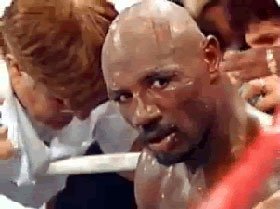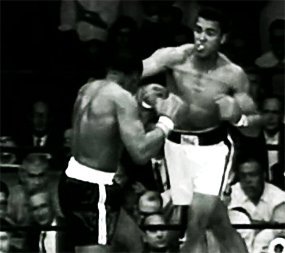Once again, Marvellous Marvin Hagler and Thomas “Hitman” Hearns would box under the bright lights of Las Vegas, this time together, on the same night, against dangerous opposition. It was almost a full year after these two warriors had gone to hell and back against one other, and the grand plan for promoter Bob Arum was to set up a Hagler-Hearns II. Fans got two thrilling fights for their money this night in 1986 – one ending via violently quick KO, the other being an absolute war of attrition – as a rematch of the greatest fight in history was in the works.
Marvin Hagler
Marvelous Marvin Hagler: boxing will never die, but we need a new superstar
Former undisputed and long-reigning middleweight king Marvelous Marvin Hagler was lucky, in that he fought during a golden era that was literally cluttered with stars and big marquee names. There was The Marvelous one himself of course, and Thomas Hearns and Roberto Duran and Sugar Ray Leonard. Hagler fought them all, along with other attractive names like John Mugabi, and this served him well – money-wise and fame-wise.
Hagler-Hearns: still the greatest fight in middleweight history – but what if there’d been a rematch?
It’s just over three decades old (31 years ago today to be exact) but no fight has surpassed the epic three-round war between Marvelous Marvin Hagler and Thomas “Hitman” Hearns since it took place in Las Vegas in 1985 – certainly no middleweight fight has topped “The War.” With seemingly reckless abandon, the two greats, who were at their peak at the time of the showdown, launched into one another. Fans, experts and even the commentators could barely do anything but watch in awe as the magnificent warfare unfolded.
Sugar Ray Leonard-Marvin Hagler: still the most controversial decision in boxing history
There have always been debatable decisions in boxing and there will continue to be so. Yet when it comes to picking one fight that is sure to cause a very passionate debate on the subject of who should have been awarded the judges’ decision, there is one fight that is the big daddy of them all: Sugar Ray Leonard’s 12-round split decision victory over reigning and defending middleweight king Marvelous Marvin Hagler.
Marvelous Marvin in the house!…Hagler visits Doncaster, UK
There must be something boxing related about the town of Doncaster in south Yorkshire, UK. A few years back, Thomas Hearns and the equally legendary Roberto Duran visited the town on a hugely enjoyable after dinner speaking tour, and last night, Marvelous Marvin Hagler was in town on a speaking engagement of his own. That’s three of The Four Kings in the past four years to have rode into Doncaster.
Last night’s event was, well, marvellous. Hagler, still a formidable looking presence, posed for photos (hundreds of them), signed autographs and took to the microphone to speak about his legendary career – one that saw him become arguably the finest middleweight ruler in boxing history.
Boxing: Five Memorable “Psych Jobs”
 Boxing is an inherently psychological undertaking. It is an activity that exposes the contestants to far more than the simple prospect of defeat: the potential combination of public humiliation and genuine physical harm percolate in a fighter’s mind to a degree that few who have not lived the experience can reasonably quantify. Far from being a mere test of physical skills then, boxing is perhaps one of the purest tests of human will power. Some of the biggest contests in boxing history have therefore been won or lost through cunning, bravery and fortitude as much as they have speed, strength and stamina.
Boxing is an inherently psychological undertaking. It is an activity that exposes the contestants to far more than the simple prospect of defeat: the potential combination of public humiliation and genuine physical harm percolate in a fighter’s mind to a degree that few who have not lived the experience can reasonably quantify. Far from being a mere test of physical skills then, boxing is perhaps one of the purest tests of human will power. Some of the biggest contests in boxing history have therefore been won or lost through cunning, bravery and fortitude as much as they have speed, strength and stamina.
All Time Historical Survey Series Recap – The Original 8 Weight Classes & P4P
by Geoffrey Ciani – Over the course of a sixteen month period beginning in June 2009, I conducted a series of surveys that all began with a very simple question: Who are the ten best heavyweights of all time? While contemplating my own list of top heavyweight pugilists, I decided gathering the input of others might help display a more accurate portrayal of what a ‘true’ top 10 list should look like. Now of course this is not an exact science by any means. In fact, quite the opposite, it is an extremely subjective topic that is often skewed by personal bias, differences of opinion, individual tastes and preferences, and most importantly the absence of a universally agreed upon criteria with which to judge past fighters. Even with these inherent obstacles playing their natural role, however, we can still establish some degree of consensus.
The guidelines were simple. I had every person who voluntarily participated in each survey provide me with a chronological list of who they considered to be the ten best (heavyweights, middleweights, etc) in boxing history. Ties were not permitted, just a straight-forward list from one to ten. I then used a weighted-points system to assign values to fighters based on where they appeared on each individual’s list. First place votes received 25 points. Second place votes were worth 15 points, third place votes were 12, and fourth and fifth place votes were worth 10 and 8 points respectively. After that, the point differential was constant, with sixth place votes getting 5 points, seventh place votes getting 4, eighth getting 3, ninth place 2, and tenth place 1.


